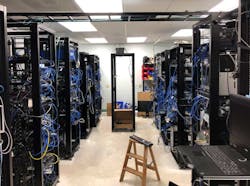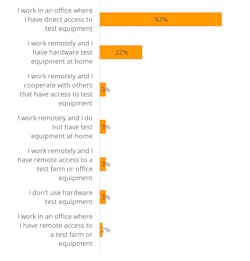FOMO, OMG, WFH, ASAP, FUTAB
In-person tradeshows are back with a vengeance, as noted by our coverage of APEC, Embedded World, and CES this year. You may have gone back or were forced to return to the office but the effect of COVID-19 remains on work-from-home (WFH), education, and tradeshows.
The contrast between WFH and education is significant. While WFH often showed improvements in output and quality, the opposite was true for most educational institutions, especially for the lower grades. This should not be surprising given the investment and the amount of change involved.
Schools that were already strapped for cash with teachers and students who were accustomed to in-person environments had to make 180 turn to virtual learning using tools never intended for this environment. Documentation was poor. Best practices were non-existent and tools like PCs, wireless communication, etc. were in short supply. It wasn't a matter of virtual learning being a poor alternative, but rather the tools and support aren't something that's easily cobbled together.
The corporate side tended to address the situation better with stipends for home offices, covering costs of internet access and extending VPNs and other tools like Teams and Zoom to the masses. Of course, many companies requiring in-person operation like restaurants were devastated; however, service-oriented companies and ones that were dealing with development and management flourished. This isn't to say that everything ran smoothly. In general, though, going virtual was a plus for employee engagement.
As it turns out, many of the tools and skills needed for virtual work are equally applicable to those who will be working in the office. Likewise, many companies have offices that are at different locations; even ones with large campuses benefit from virtual collaboration tools. Green Hills Software had already put together a testing lab designed for remote access before COVID hit (Fig. 1).
Virtual Pendulum Swings
Vaccines have changed the health landscape such that working in the office and traveling to tradeshows is now possible without the potential for catching something lethal. Some tradeshows have come back strong with attendance exceeding shows before COVID, despite the higher cost of travel. I suspect that the costs will mitigate this in the long run, but it's obvious that we like to meet in person.
That's not to say the days of virtual trade shows are numbered. In fact, I prefer hybrid shows, and many have taken this route. A number of large virtual tradeshows have become very successful. The infrastructure for running these shows has been evolving—there's still a lot that could be done to improve them. Time, travel, and travel costs are a major impediment to attending in-person events and the benefit is often dubious, making virtual events more appealing.
As mentioned earlier, we've been covering many of the in-person events. However, we're also on top of those that are hybrid and completely virtual. We're not immune to the costs and time required for in-person events and we're even running virtual events like those on Engineering Academy. Our parent company, Endeavor Business Media, even has its own in-person tradeshow group that's very happy about the increased attendance of its shows.
I recently did some presentations at the Trenton Computer Festival and IEEE ITPC event held at the College of New Jersey campus that had video-conferencing setups in all classrooms. Half of my audience was virtual and the recorded versions were available for viewing after the conference ended.
WFH also has taken a turn, as working from the office (WFO) is now safe. Unfortunately, many factors have come into play. Some companies demand WFO sometimes to the exclusion of WFH, with many employees resisting. Others have taken a hybrid approach—WFH for a few days or coming in for some meetings.
The problem is that some demands for WFO are being pushed for executives' personal reasons or for financial reasons like paying for office space that wasn't used by WFH employees. A number of organizations are adapting and downsizing physical locations, but companies with large corporate campuses often have ownership of financial commitments that can't be changed in the near term.
Retaining employees, especially important ones, is often easier with a flexible or more liberal WFH policy. Likewise, attracting new employees is usually easier as well. Certain jobs do require WFO because of equipment requirements as our informal poll showed (Fig. 2). This was a short poll that did not ask about WFH/WFO issues, so some may have to be in the office all of the time or just some of the time.
A Bit About the Article Title
The title was certainly created to garner interest, but was also chosen to reflect how we're collaborating. Emoticons, acronyms, and chat sessions have become the norm, not only for general social media, but also for work collaboration. Chat sessions in tools like Microsoft Teams have features to make this easier and it's not unusual for people to use acronyms in their discussions. Social-media systems like Twitter, Discord, and Slack are rife with short messages that are compacted with acronyms and emojis.
Doing WFH completely for the past 40 years, I can say that it's possible, and having the rest of the world join in has made my job easier and more interesting. I still love to meet people face-to-face, but working remotely has significant advantages.
Now if only the improvements keep on coming.
About the Author
William G. Wong
Senior Content Director - Electronic Design and Microwaves & RF
I am Editor of Electronic Design focusing on embedded, software, and systems. As Senior Content Director, I also manage Microwaves & RF and I work with a great team of editors to provide engineers, programmers, developers and technical managers with interesting and useful articles and videos on a regular basis. Check out our free newsletters to see the latest content.
You can send press releases for new products for possible coverage on the website. I am also interested in receiving contributed articles for publishing on our website. Use our template and send to me along with a signed release form.
Check out my blog, AltEmbedded on Electronic Design, as well as his latest articles on this site that are listed below.
You can visit my social media via these links:
- AltEmbedded on Electronic Design
- Bill Wong on Facebook
- @AltEmbedded on Twitter
- Bill Wong on LinkedIn
I earned a Bachelor of Electrical Engineering at the Georgia Institute of Technology and a Masters in Computer Science from Rutgers University. I still do a bit of programming using everything from C and C++ to Rust and Ada/SPARK. I do a bit of PHP programming for Drupal websites. I have posted a few Drupal modules.
I still get a hand on software and electronic hardware. Some of this can be found on our Kit Close-Up video series. You can also see me on many of our TechXchange Talk videos. I am interested in a range of projects from robotics to artificial intelligence.



